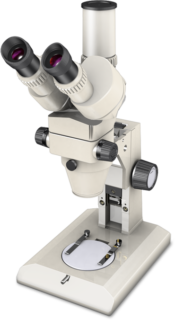Nikon’s Museum of Microscopy
Model SMZ-2T Stereomicroscope
( Circa 1987 )
The Nikon SMZ-2T microscope is a trinocular stereoscopic model that was designed to easily accept a closed-circuit television (CCTV) or newer CCD-based digital camera or any of Nikon's FX photomicrographic systems. A switchover control ring in the trinocular head allows the microscopist to rapidly change from stereoscopic binocular viewing of specimens through the paired eyepieces to photo video capability.

Nikon engineers broadened the zoom range for the SMZ-2T to include magnifications from 1x to 6.3x, which are particularly useful in dissections and photomacroscopy. Auxiliary objectives and eyepieces extend the magnification range for the stereo zoom microscope from 5x to about 416x. However, if a 0.5 or 0.7x auxiliary objective is installed, the working distance increases and an extension ring or pillar is required to achieve a satisfactory focusing distance.
Though the SMZ-2T illustrated above is shown with a plain focusing stand, a variety of stages and stands may be utilized with the instrument. For instance, an attachable diascopic illuminator base and a diascopic illuminator stand facilitate transmitted light applications, a fine focusing stage enables easy photomicrography focusing, and a circular floating stage accommodates a variety of specimens. Several illuminator options are also available for the microscope. The standard is a 6-volt, 10-watt halogen illuminator, but simple coaxial, universal, fiber-optic bifurcated, and fluorescent ring illuminators may be alternatively utilized. Options of installing the illuminator above the stage on the stand for epi-illumination, in the base for diascopic lighting, or on an external stand give the microscopist further technique flexibility.
Today Nikon offers a number of different stereomicroscopes in its SMZ series.













